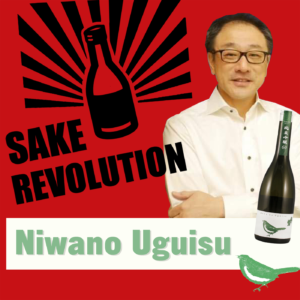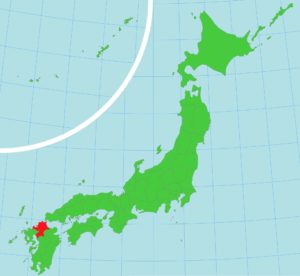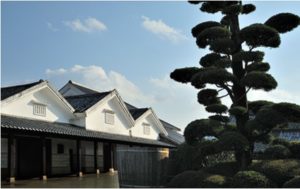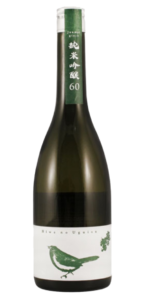Episode 49 Show Notes
 Season 1. Episode 49. While we’ve done a fair number of interviews on Sake Revolution, today marks the start of something special as we challenge ourself to reach out in a new direction. To start off, it’s important to know that the word “kuramoto” means “Japanese Sake Brewery President.” We’re beginning our first in a series of sit down talks with Kuramoto in Japan. Our first guest is Mr. Testuo Yamaguchi. He is the 11th generation president of Yamaguchi Shuzojo in Fukuoka Prefecture, and is the maker of the “Niwano Uguisu” (Garden’s Nightingale) brand of sake. Mr. Yamaguchi was kind enough to take time to chat with us about his brewery and tell us quite a bit about his brewing philosophy. There is a strong emphasis on pairing with the local cuisine – a platform that we can really get behind! Together we taste one of Yamaguchi-san’s flagship products, the Niwano Uguisu “Garden’s Nightingale” Junmai Ginjo 60. It’s a delightful sake – just look for the unmistakeable nightingale bird on the label. Our special thanks to Mr. Yamaguchi for this fun and enlightening talk! Enjoy this first of many Kuramoto chats to come!
Season 1. Episode 49. While we’ve done a fair number of interviews on Sake Revolution, today marks the start of something special as we challenge ourself to reach out in a new direction. To start off, it’s important to know that the word “kuramoto” means “Japanese Sake Brewery President.” We’re beginning our first in a series of sit down talks with Kuramoto in Japan. Our first guest is Mr. Testuo Yamaguchi. He is the 11th generation president of Yamaguchi Shuzojo in Fukuoka Prefecture, and is the maker of the “Niwano Uguisu” (Garden’s Nightingale) brand of sake. Mr. Yamaguchi was kind enough to take time to chat with us about his brewery and tell us quite a bit about his brewing philosophy. There is a strong emphasis on pairing with the local cuisine – a platform that we can really get behind! Together we taste one of Yamaguchi-san’s flagship products, the Niwano Uguisu “Garden’s Nightingale” Junmai Ginjo 60. It’s a delightful sake – just look for the unmistakeable nightingale bird on the label. Our special thanks to Mr. Yamaguchi for this fun and enlightening talk! Enjoy this first of many Kuramoto chats to come!
Skip to: 00:19 Hosts Welcome and Introduction
Welcome to the show from John and Timothy
Skip to: 01:27 Kuramoto Interivew: Tetsuo Yamaguchi with Niwano Uguisu


The largest river in the Kyushu region of Japan is the Chikugogawa. The abundance of pure, clean water in the Chikugo region is said to have given birth to one of the three largest sake-brewing regions in Japan; many breweries were born there. The brewer of Niwa no Uguisu (aka. “Garden’s Nightingale”) is Yamaguchi Shuzojo: located in northern Chikugo. The very first brewers of Yamaguchi Shuzojo loved to watch the Japanese nightingales in the garden playing in the water and drinking in the gardens. When the 6th generation family head Yamaguchi Risuke saw this, he made the decision to brew sake using that water.
The Nightingale is colored and positioned differently on every one of the Kura’s 17-20 annually-released sake. Tetsuo Yamaguchi (11th generation) explains “The first generation of sake brewers from my family enjoyed listening to the birds while drinking sake.” The brewery’s motto for their sake is: food comes first; sake comes second. When asked what makes Niwa No Uguisu so special, Tetsuo-san replied, “I can list three things that differentiate us from other breweries: rice, water and people.”
Check out this video to see some of the interior of Yamaguchi Shuzojo:
Skip to: 13:15 Niwa no Uguisu “Garden’s Nightingale” Junmai Ginjo
Niwa no Uguisu “Garden’s Nightingale” Junmai Ginjo

Acidity: 1.5
Alcohol: 15.0%
Brand: Niwa No Uguisu (庭のうぐいす)
Brewery: Yamaguchi Shuzojo
Classification: Junmai Ginjo
Importer: Mutual Trading (USA)
Prefecture: Fukuoka
Rice Type: Yamadanishiki, Yumeikkon
Sake Name English: Nightingale’s Garden
Seimaibuai: 60%
SMV: +3.0
Skip to: 21:46 Show Closing
This is it! Join us next time for another episode of Sake Revolution!
Episode 49 Transcript
John Puma: 0:22
Hello everybody. And welcome to Sake Revolution. This is America’s first sake podcast. I’m your host, John Puma from the Sake Notes. You may also know me from the internet Sake Discord. It’s a little place that I run on the side.
Timothy Sullivan: 0:36
And I am your host, Timothy Sullivan. I am a Sake Samurai. I’m a sake educator, as well as the founder of the Urban Sake website. And every week, John and I will be tasting and chatting about all things, Sake. And doing our best to make it fun and easy to understand.
John Puma: 0:53
Wonderful. And, Tim, this is a very special episode of Sake Revolution. This is something that we’ve been talking about doing for a very long time amongst ourselves.
Timothy Sullivan: 1:03
Very exciting, very
John Puma: 1:04
Very exciting. What is it?
Timothy Sullivan: 1:06
We are going international. John Puma, we are having a very special guest join us today. And it is our first Japanese Sake brewery president interview.
John Puma: 1:22
that sounds like a tremendous amount of fun. Who is joining us today?
Timothy Sullivan: 1:27
I would like to welcome Mr. Yamaguchi. He is the 11th generation presidents of Yamaguchi Shuzojo, which is a brewery in Fukuoka, Japan, and they make the very delicious Niwano Uguisu brand of sake. So I’d like to welcome Mr. Yamaguchi. So Mr. Yamaguchi, could you start by giving us a brief self-introduction and telling us a bit about your brewery?
Tetsuo Yamaguchi: 1:59
Hello. My name is Tetsuo Yamaguchi. I am 11th generation kuramoto at Yamaguchi Shuzojo. I have been doing this for 20 years The sakagura has been creating sake for 191 years in total. So my sake brewery is in Kurumeshi, Fukuoka, where, making is quite famous. Since two years ago, we have been harvesting rice from our regional and local rice paddies we try to be as local as possible in our sake making.
John Puma: 2:35
So at what point did you start exporting your sake to the West? And, where did you start?
Tetsuo Yamaguchi: 2:46
We introduced our sake to America in 1997. First in New York. Currently we export to 13 countries, but, America was the very first country for us to introduce our sake outside of Japan. The first sake we introduced to America was “kan” type, the warm type. This is due to the rice that we used. We use what’s called a “katai kome”, a hard rice. Which, needs to be rested for some time for it to have its taste. But since then, the Prefecture of Fukuoka stopped making these hard rice and started making more softer rice. And so, although the sake that we first introduced to New York in 1997 was quite popular, we had to stop exporting those type of It has been three years since we started exporting our new type of sake to New York and to LA. It is the quite opposite type from the ones that we exported in 1997, It is freshly squeezed. It has more fragrance. It’s not sweet, so it is good to pair with food. The reason why we try to use the rice from the region and for Fukuoka and Kyushu is because we believe that it goes well with the food that is the regional food of Kyushu.
Timothy Sullivan: 4:23
Yeah, that’s right. So I was wondering if you could tell us a little bit more detail about the cuisine of Kyushu. What should we look for when we’re enjoying that food from your region?
Tetsuo Yamaguchi: 4:40
So the characteristics of typical Kyushu food is it’s known for its freshness. It’s known for its balancing oil is known for its sweet and nice balance of soy sauce. And so we always wanted to come up with a Sake that matches the Kyushu food style.
John Puma: 5:01
Um, so could you tell us a little bit about your life before you came to work at the brewery? Um, did you always live down in Fukuoka where you were you a big sake drinker beforehand?
Tetsuo Yamaguchi: 5:19
So before working at the brewery in my twenties, I lived in Tokyo. There, I fell in love with wine and I was drinking wine every day. I actually never had a sake back then. And even when I came back to, to Kyushu, I kept drinking wine and I noticed that sauvignon blanc has a very clean aroma it’s got a brisk and refreshing taste, which goes very well with the Kyushu food. I started creating sake in my thirties, but my goal and aim was always to go with the sauvignon blanc feel. And I have this, brand called the Junmai Ginjo 60, which uses the green label with the Nightingale on it. And that color got hint from the sauvignon We really want you to, try out our Junmai Ginjo 60 first because it really harnesses the weather and the regional atmosphere of the kyushu area. And it really goes well with, the Kyushu food. Because their Sake is freshly pressed and exported right out of the brewery, we feel that the sake is still very fresh. It goes well with, oily food, because it has this refreshing quality to it and it makes you want to eat more of the food and it wants to, have more of the sake. Some of the characteristics of Kyushu food is that it is very fresh. It comes directly from the ocean or from the farms. We eat things like mackerel, which even in Japan, many people do not eat raw. We would eat raw here. We would use simple seasoning like lemons or citrus. And so if everything is very fresh and comes directly from the environment.
John Puma: 7:17
So, tell us a little bit about the brand name, the Niwano Uguisu. What does that mean?
Tetsuo Yamaguchi: 7:31
So the name literally means Garden Nightingale. So in Japan Nightingale, I don’t know if this bird exists in America, but it usually, has this connotation, meaning that it has a very soothing, nice chirping sound. And so people who have a good voice or singing voice is often called to have a nice nightingale sound in Japan. The first-generation Sakamoto. He loved sake very much. And what he would do is he would, in the spring time, listen to the Nightingales, taking a bath in the water, and as the birds would, bathe and chirp, he would drink his favorite sake. And this is where he got the name Niwano Uguisu.
Timothy Sullivan: 8:28
Oh, gosh, that sounds very picturesque, John. Now, can you envision yourself relaxing in the garden, sipping on sake and watching the Nightingales splash in the fountain? I can envision that for myself.
John Puma: 8:41
Yeah. I mean, Tim first off, it’s making me suddenly want a garden, which I didn’t think I’d ever really say. But yeah, I think the idea of sitting out there with some sake, listening to some birds chirping, it sounds, that sounds really kind of picturesque right about now.
Timothy Sullivan: 8:55
Yeah. And it’s not uncommon for Japanese sake breweries to have their family home attached to the brewery and the nice enclosed garden right next door. And you can do moon watching and snow watching. And these brewers obviously were. Uh, birdwatching. So I think that’s absolutely fantastic. Now, Yamaguchi san, did you always know that you were going to grow up to be the president of this brewery? And I also want to ask you, what was it like as a child kind of growing up in this environment?
Tetsuo Yamaguchi: 9:34
Yeah. So as a child, I didn’t think that growing up in a brewery was anything special. But now that I think about it, the house is really big and it has over 50 rooms. It is old, there were many, many places for us kids to run around, but I didn’t really think much of it as a child. I always thought that I would be working in the sake brewery industry, but in my mind, I always wanted to start maybe after retirement, maybe after 68 years old, but, the 10th generation, my father, he fell ill at one point and I had to take his position and my dream was to live abroad. And to work abroad, but that never really happened. Uh, So I had to give that dream up, but now that I look back, I’m very glad that I was able to be in the sake industry at my age.
John Puma: 10:34
What are your views of the overseas market since, you had mentioned that your sake has gone over there and also has, changed the type that gets exported. What are your thoughts on the overseas market overall?
Tetsuo Yamaguchi: 10:48
There’s some stories I have from my challenges exporting our sake outside of Japan. the first challenge came, in New York in 1997, I noticed that people are drinking sake in a very different manner from that of the Japanese. They might, warm up this sake too much, so much so that it’s too hot to hold in their hands or keep this sake stored in a room temperature, just like they might do for wine and for, wine glasses. I thought this was very unique for, a global, audience. And at the same time, I realized that, not much education was had, in terms of sake at that point. But I’m seeing a lot of changes recently. So I have a good friend Chizu in New York and she is educating people on how to drink sake. And how to serve sake and she’s using, many different methods, such as humor to, educate people in the art of sake drinking. Unlike before, or I’m seeing more and more people, enjoying the art of pairing sake with, food, and I’m hoping that in the 10, 20, 30 years to come, if people keep continuing this, education of sake, New York can be the epicenter of sake,in the world. But if I look at Asia or in Europe, people drink sake very differently. For example, in Asia, people prefer more expensive and exclusive sake. A few other Americans on the other hand are starting to really, really enjoy, sake, including pairing and, I hope that this is the way that things go in the future.
Timothy Sullivan: 13:08
Excellent. So I I’m really curious as a sake brewer in Japan, what are your ideas, impressions, what are your thoughts about those brewers that are making sake overseas? Like sake brewers in New York and the USA? What are your feelings about that?
Tetsuo Yamaguchi: 13:31
I completely agree with this, and I hope that there will be more and more sakaguras around the world. I am very much for it.
Timothy Sullivan: 13:39
Excellent. We are too.
Tetsuo Yamaguchi: 13:42
So I went to Brooklyn Kura recently and I had the sake there and I thought it was excellent.
Timothy Sullivan: 13:49
Wonderful. That’s great.
John Puma: 13:51
So I think it is the time on our, on the show, our favorite time on the show where we will, taste and talk about the actual sake. So yes, we both have Tim and I, and, Yamaguchi-san, all have a bottle of the Niwano Uguisu this is the Junmai Ginjo 60.
Timothy Sullivan: 14:08
so, we’re going to pour this into our glass. Now, would you mind introducing this sake to our listeners?
Tetsuo Yamaguchi: 14:17
Yeah. So this is the Niwano Uguisu Junmai Ginjo, 60. but it’s one of the first that we make and the year milling is 60% and you can enjoy both the good and the best of the rice. Yes. It really goes well with any food or cuisine. Raw food, or even with meat or fish. I always have this sake in my fridge, but please don’t chill too much. it has a very fruity quality to it. It might invoke the sense of melon or muscat, a very green fruit. And so it is very refreshing and hope it will make you want to eat more. I hope you enjoy the sake
Timothy Sullivan: 15:02
thank you. So I noticed that you use a rice that we’re not as familiar with. Yumeikkon as the kakemai for this that’s the rice, that’s the starch component in the mash. Can you tell us about yumeikkon and why you selected that rice to use?
Tetsuo Yamaguchi: 15:27
okay. Yumeikkon, this rice is a product of my region in, Kurumeshi Fukuoka it’s most characteristic is that it’s very soft. And soft rice usually has a very complex taste. And initially it might create a more solid dense taste, but when it is freshly squeezed, it creates a more refreshing taste. And so we use this freshness in our sake, but sake made with this rice is not recommended for long-term aging. Let’s say if it is rusted in minus five degrees centigrade for a long time, this sake will not taste good. And so it needs to have a healthy fermentation, and it has to be a drank within half a year or a year.
John Puma: 16:22
That’s good to know. So Tim, what did you think about this
Timothy Sullivan: 16:28
I absolutely agree with what Mr. Yamaguchi said about the aroma. I’m definitely getting a lightly fruity aroma and, I think it’s very delicate and very delicious aroma. and John, what, what do you think about the aroma
John Puma: 16:46
the melon was the first thing that I noticed. I want to stay away from wafting jokes, but it’s there. That comes across really, cleanly though, that fresh melon it’s it’s a wonderful aroma.
Timothy Sullivan: 16:57
One thing that I’m left with after sipping on the sake is that the finish is relatively dry. Do you think that as well, John.
John Puma: 17:07
a bit, it lingers. But it is a dry lingering finish, which is, uh, uh, interesting and a little unusual, but I like that a lot. I think that this, will go towards what Yamaguchi-san was saying earlier about the, types of food that the sake was meant to go with.
Timothy Sullivan: 17:25
Mr Yamaguchi, could you speak to that point about the finish and if you think it’s dry and if it’s meant to pair with food in that way.
Tetsuo Yamaguchi: 17:40
I absolutely agree with what you were saying, and I’m happy that you noticed that. Yes, we are absolutely going for that, freshness afterwards. So we are going for the dry after taste, as it goes well with any and all sorts of food. My philosophy is that food comes first and sake is always secondary. sake should always accentuate the food and Sake’s taste should not linger in the mouth. so I think that all sake should really go with food. sometimes having decided to be a bit too dry or a bit too bitter, is saying that it goes well with food. And so I’m hoping that Junmai Ginjo 60, the one we try today, is a good example of that.
John Puma: 18:26
Wonderful now, we noticed that the, labels on the Sake is very unique, very unusual. It looks different from other sake labels being shorter, and even the bottle shape looks a little bit different, perhaps. Um, what are your thoughts on that?
Tetsuo Yamaguchi: 18:52
so we have two main different types of sake. One is more masculine. One is more feminine. This is just the image. Uh, the male one can be a little bit more dry. The female one can be more fruity The one we have today is more masculine. It goes well with all types of food
Timothy Sullivan: 19:14
just a couple more questions before we wrap up, I’d like to ask you: For the future, what are your hopes for the Japanese sake industry in Japan and also abroad?
Tetsuo Yamaguchi: 19:33
every time I go abroad, I am energized. I am so happy to see people enjoying sake. And so I just hope that this continues that people enjoy sake for what it is.
John Puma: 19:48
Mr. Yamaguchi. Thank you so much for coming. Do you have any, messages for our listeners?
Tetsuo Yamaguchi: 19:58
There’s one thing that, sake can do, but other alcohol might not be able to do. And that’s when you drink sake, you become friendly with everyone around you.
Timothy Sullivan: 20:11
Oh, yes. I’ve seen John be very friendly with people around him.
John Puma: 20:18
Sometimes the sake it does sake. I definitely helped. Let me tell you that does, and I think that there’s something unique about sake that does bring that out. I mean, it breaks it out immediately.
Timothy Sullivan: 20:28
And if it does make people very friendly and that’s something I’ve always loved about drinking Sake with people, you always end up talking to the people next to you, I’ve seen it happen many times. And especially in Japan.
John Puma: 20:40
Yeah. I, I don’t know too many. Um, I don’t do many angry sake jokes. I don’t think it works that way.
Tetsuo Yamaguchi: 20:51
And so it is my hope that you drink sake with the people that is important to you, or you want to become friends with. Please enjoy Sake, and we hope that you can come to Japan soon.
Timothy Sullivan: 21:08
Well, that’s fantastic.
John Puma: 21:10
can’t wait.
Timothy Sullivan: 21:13
Thank you so much. That was a wonderful interview and your sake is absolutely delicious. I’m enjoying it so much.
John Puma: 21:24
always a treat to have this it’s wonderful.
Timothy Sullivan: 21:27
Thank you so much.
John Puma: 21:29
Ah, we want to thank Mr. Yamaguchi for, becoming our first. Our first, hopefully of many international guest. I have had a wonderful time at drinking his sake. It’s absolutely delicious. Uh, yeah, very much so
Timothy Sullivan: 21:46
And in addition to Mr. Yamaguchi, we want to thank all of our listeners as well for tuning in. We really do hope that you’re enjoying Sake Revolution. If you’d like to show your support for our show, there’s one way you can really help us out. And that would be to take a couple of minutes and leave us a written review on Apple podcasts.
John Puma: 22:04
and also please tell a friend and they get your friend to subscribe and then set a good example by subscribing yourself this way. Every week, when we put out a new episode, it’ll show up on your device of choice and you don’t even have to like be awake and, click anything. It just happens.
Timothy Sullivan: 22:20
Okay. And as always to learn more about Niwano Uguisu this delicious sake from Fukuoka or anything we talked about in today’s episode, be sure to visit our website, SakeRevolution.com for all the detailed show notes.
John Puma: 22:37
If you have sake questions that you need answered, if you have international Kuramotos that you’d like us to interview, you know, we want to hear from you. We want to hear your suggestions. Please reach out to us. The email address is [email protected]. And so until next time, please remember everybody keep drinking Sake and KANPAI!.